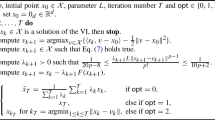Abstract
This paper develops new semidefinite programming (SDP) relaxation techniques for two classes of mixed binary quadratically constrained quadratic programs and analyzes their approximation performance. The first class of problems finds two minimum norm vectors in N-dimensional real or complex Euclidean space, such that M out of 2M concave quadratic constraints are satisfied. By employing a special randomized rounding procedure, we show that the ratio between the norm of the optimal solution of this model and its SDP relaxation is upper bounded by \(\frac{54M^2}{\uppi }\) in the real case and by \(\frac{24M}{\sqrt{\uppi }}\) in the complex case. The second class of problems finds a series of minimum norm vectors subject to a set of quadratic constraints and cardinality constraints with both binary and continuous variables. We show that in this case the approximation ratio is also bounded and independent of problem dimension for both the real and the complex cases.




Similar content being viewed by others
Notes
There is another way to do the relaxation, i.e., the SDP relaxation for both the discrete and the continuous constraints. However, it can be similar to that in [19] to prove that the two SDP relaxation problems are equivalent. Due to its smaller problem size, the SDP relaxation problem (SDP1) is preferred.
The probability that no such \({{\xi }}^{(1)}\) or \({{\xi }}^{(2)}\) is generated after N independent trials is at most \((1-0.075\,8\cdots )^N\). When \(N=100\), the probability equals \(0.000\,375\cdots \). Thus, such \({{\xi }}^{(1)}\) or \({{\xi }}^{(2)}\) requires relatively few trials to generate, see also in [2].
References
Xu, Z., Hong, M.: Approximation algorithm for a mixed binary quadratically constrained quadratic programming problem. Pac. J. Optim. 11, 239–255 (2015)
Luo, Z.-Q., Sidiropoulos, N.D., Tseng, P., Zhang, S.: Approximation bounds for quadratic optimization with homogeneous quadratic constraints. SIAM J. Optim. 18, 1–28 (2007)
Beck, A., Teboulle, M.: A convex optimization approach for minimizing the ratio of indefinite quadratic functions over an ellipsoid. Math. Progr. 118, 13–35 (2009)
Ben-Tal, A., Nemirovski, A., Roos, C.: Robust solutions of uncertain quadratic and conic-quadratic problems. SIAM J. Optim. 13, 535–560 (2002)
He, S., Luo, Z.-Q., Nie, J., Zhang, S.: Semidefinite relaxation bounds for indefinite homogneous quadratic optimization. SIAM J. Optim. 19, 503–523 (2008)
Nemirovski, A., Roos, C., Terlaky, T.: On maximization of quadratic form over intersection of ellipsoids with common center. Math. Progr. 86, 463–473 (1999)
Goemans, M.X., Williamson, D.P.: Improved approximation algorithms for maximum cut and satisfiability problems using semidefinite programming. J. ACM 42, 1115–1145 (1995)
Frieze, A.M., Jerrum, M.: Improved approximation algorithms for max k-cut and max bisection. In: Proceedings of the 4th International Conference on Integer Programming and Combinatorial Optimization, pp. 1–13. Springer, London (1995)
Ye, Y.: A.699-approximation algorithm for max-bisection. Math. Progr. 90, 101–111 (2001)
Billionnet, A., Elloumi, S., Lambert, A.: Extending the QCR method to general mixed-integer programs. Math. Progr. 131, 381–401 (2012)
Billionnet, A., Elloumi, S., Plateau, M.-C.: Improving the performance of standard solvers for quadratic 0–1 programs by a tight convex reformulation: the QCR method. Discr. Appl. Math. 157, 1185–1197 (2009)
Burer, S., Saxena, A.: The MILP road to MIQCP. In: Lee, J., Leyffer, S. (eds.) Mixed-Integer Nonlinear Programming. IMA Volumes in Mathematics and Its Applications, vol. 154, pp. 373–406. Springer, Berlin (2011)
Saxena, A., Bonami, P., Lee, J.: Convex relaxations of non-convex mixed integer quadratically constrained programs: extended formulations. Math. Progr. 124, 383–411 (2010)
Saxena, A., Bonami, P., Lee, J.: Convex relaxations of non-convex mixed integer quadratically constrained programs: projected formulations. Math. Progr. 130, 359–413 (2011)
Burer, S., Letchford, A.: Non-convex mixed-integer nonlinear programming: a survey. Surv. Oper. Res. Manag. Sci. 17, 97–106 (2012)
Hemmecke, R., Koppe, M., Lee, J., Weismantel, R.: Nonlinear integer programming. In: Junger, M., et al. (eds.) 50 Years of Integer Programming 1958–2008, pp. 561–618. Springer, Berlin (2010)
Koppe, M.: On the complexity of nonlinear mixed integer optimization. In: Lee, J., Leyffer, S. (eds.) Mixed-integer Nonlinear Programming. IMA Volumes in Mathematics and Its Applications, Vol. 154, pp. 533–558. Springer, Berlin (2011)
Hong, M., Xu, Z., Razaviyayn, M., Luo, Z.-Q.: Joint user grouping and linear virtual beamforming: complexity, algorithms and approximation bounds. IEEE J. Sel. Areas Commun. 31, 2013–2027 (2013)
Xu, Z., Hong, M., Luo, Z.-Q.: Semidefinite approximation for mixed binary quadratically constrained quadratic programs. SIAM J. Optim. 24(3), 1265–1293 (2014)
Grant, M., Boyd, S.: CVX: Matlab software for disciplined convex programming, version 1.21. April 2011
Author information
Authors and Affiliations
Corresponding author
Additional information
The first author’s research was supported by the National Natural Science Foundation of China (No. 11101261).
Rights and permissions
About this article
Cite this article
Xu, Z., Hong, MY. Semidefinite Relaxation for Two Mixed Binary Quadratically Constrained Quadratic Programs: Algorithms and Approximation Bounds. J. Oper. Res. Soc. China 4, 205–221 (2016). https://doi.org/10.1007/s40305-015-0082-2
Received:
Revised:
Accepted:
Published:
Issue Date:
DOI: https://doi.org/10.1007/s40305-015-0082-2
Keywords
- Nonconvex quadratically constrained quadratic programming
- Semidefinite program relaxation
- Approximation bound
- NP-hard




